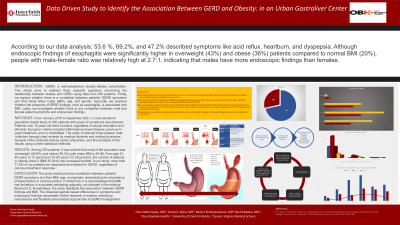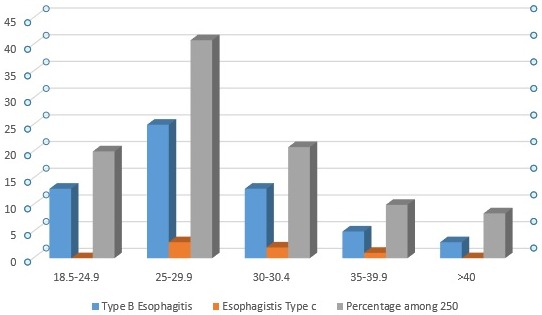Monday Poster Session
Category: Stomach
P2765 - Data Driven Study to Identify the Association Between GERD and Obesity: In an Urban Gastroliver Center
Monday, October 23, 2023
10:30 AM - 4:15 PM PT
Location: Exhibit Hall

Has Audio

Uma D. Gupta, MD
One Brooklyn Health-Interfaith Medical Center
Brooklyn, NY
Presenting Author(s)
Uma D. Gupta, MD1, Tasniem Tasha, MD2, Basher M. Atiquzzaman, MD3, Neville Kadakia, MD4
1One Brooklyn Health-Interfaith Medical Center, Brooklyn, NY; 2Eastern Virginia Medical School, Norfolk, VA; 3University of Central Florida, Orlando, FL; 4Interfaith Medical Center, Brooklyn, NY
Introduction: GERD is a well-established obesity-related complication. This article aims to address three research questions concerning the relationship between obesity and GERD using data from 250 patients. Firstly, we explore whether there is a correlation between patients' GERD symptoms and their Body Mass Index (BMI), age, and gender. Secondly, we examine whether the presence of GERD findings, such as esophagitis, is associated with BMI. Lastly, we investigate whether there is any correlation between male and female patient symptoms and endoscopic findings.
Methods: From January 2019 to September 2021, a cross-sectional population-based study of 250 patients with upper GI symptoms was planned. Patients over 18 years old were included, regardless of sexual orientation and ethnicity. Exclusion criteria included inflammatory bowel disease, previous H. pylori treatment, and co-morbidities. The study comprised three phases: data collection through chart reviews by medical students and visiting physicians, analysis of the collected data by senior physicians, and final analysis of the results using current statistical methods.
Results: Among 250 patients, it was evident that most of the population was overweight (40.8%) and obese (39.2%),with mean BMI is 29.99, From age 31-40 years (3.12 percent) to 51-60 years (12.28 percent), the number of patients in obesity class II (BMI 35-39.9) has increased fourfold. According to our data analysis, 53.6 %, 69.2%, and 47.2% described symptoms like acid reflux, heartburn, and dyspepsia. In our study, more than 71.6% of our patients are diagnosed and treated for GERD, regardless of previous treatment response. Although endoscopic findings of esophagitis were significantly higher in overweight (43%) and obese (36%) patients compared to normal BMI (20%), people with male-female ratio was relatively high at 2.7:1, indicating that males have more endoscopic findings than females.
Discussion: The study results provide correlations between patients' GERD symptoms and their BMI, age, and gender, emphasizing the importance of these factors in clinical practice. Furthermore, it is acknowledged that BMI has limitations in accurately estimating adiposity, as indicated in the existing literature. Nonetheless, the study highlights the association between GERD findings and BMI. The observed gender-based differences in symptoms and endoscopic findings necessitate further research to explore underlying mechanisms and facilitate personalized approaches to GERD management.

Disclosures:
Uma D. Gupta, MD1, Tasniem Tasha, MD2, Basher M. Atiquzzaman, MD3, Neville Kadakia, MD4. P2765 - Data Driven Study to Identify the Association Between GERD and Obesity: In an Urban Gastroliver Center, ACG 2023 Annual Scientific Meeting Abstracts. Vancouver, BC, Canada: American College of Gastroenterology.
1One Brooklyn Health-Interfaith Medical Center, Brooklyn, NY; 2Eastern Virginia Medical School, Norfolk, VA; 3University of Central Florida, Orlando, FL; 4Interfaith Medical Center, Brooklyn, NY
Introduction: GERD is a well-established obesity-related complication. This article aims to address three research questions concerning the relationship between obesity and GERD using data from 250 patients. Firstly, we explore whether there is a correlation between patients' GERD symptoms and their Body Mass Index (BMI), age, and gender. Secondly, we examine whether the presence of GERD findings, such as esophagitis, is associated with BMI. Lastly, we investigate whether there is any correlation between male and female patient symptoms and endoscopic findings.
Methods: From January 2019 to September 2021, a cross-sectional population-based study of 250 patients with upper GI symptoms was planned. Patients over 18 years old were included, regardless of sexual orientation and ethnicity. Exclusion criteria included inflammatory bowel disease, previous H. pylori treatment, and co-morbidities. The study comprised three phases: data collection through chart reviews by medical students and visiting physicians, analysis of the collected data by senior physicians, and final analysis of the results using current statistical methods.
Results: Among 250 patients, it was evident that most of the population was overweight (40.8%) and obese (39.2%),with mean BMI is 29.99, From age 31-40 years (3.12 percent) to 51-60 years (12.28 percent), the number of patients in obesity class II (BMI 35-39.9) has increased fourfold. According to our data analysis, 53.6 %, 69.2%, and 47.2% described symptoms like acid reflux, heartburn, and dyspepsia. In our study, more than 71.6% of our patients are diagnosed and treated for GERD, regardless of previous treatment response. Although endoscopic findings of esophagitis were significantly higher in overweight (43%) and obese (36%) patients compared to normal BMI (20%), people with male-female ratio was relatively high at 2.7:1, indicating that males have more endoscopic findings than females.
Discussion: The study results provide correlations between patients' GERD symptoms and their BMI, age, and gender, emphasizing the importance of these factors in clinical practice. Furthermore, it is acknowledged that BMI has limitations in accurately estimating adiposity, as indicated in the existing literature. Nonetheless, the study highlights the association between GERD findings and BMI. The observed gender-based differences in symptoms and endoscopic findings necessitate further research to explore underlying mechanisms and facilitate personalized approaches to GERD management.

Figure: Figure 1: Incidence of Esophagitis among different BMI and total population
Disclosures:
Uma Gupta indicated no relevant financial relationships.
Tasniem Tasha indicated no relevant financial relationships.
Basher Atiquzzaman indicated no relevant financial relationships.
Neville Kadakia indicated no relevant financial relationships.
Uma D. Gupta, MD1, Tasniem Tasha, MD2, Basher M. Atiquzzaman, MD3, Neville Kadakia, MD4. P2765 - Data Driven Study to Identify the Association Between GERD and Obesity: In an Urban Gastroliver Center, ACG 2023 Annual Scientific Meeting Abstracts. Vancouver, BC, Canada: American College of Gastroenterology.
